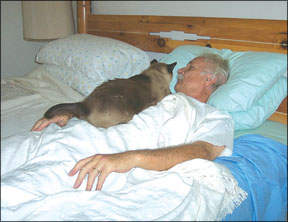Nothing is more appealing to many feline-loving people than snuggling up with a favorite cat companion, whether it be while watching television, reading a book or even catching some Zs. “A lot of people really enjoy sleeping with a cat as long as the person does not have allergies or medical conditions that would make Bev Caldwell 288 getting a scratch potentially dangerous,” says Ellen Lindell, VMD, a board-certified veterinary behaviorist who operates a private behavior specialty practice and is a monthly columnist for 
The Habit Starts in Kittenhood
Newborn kittens snuggle with their mothers for warmth, and they often continue to appreciate snuggling into adulthood. Snuggling in bed with their person provides many cats with comfort and contentment. If you tend to sleep peacefully through the night, having Fluffy draped across your legs or wedged comfortably next to your body probably helps make you feel warm and contented as well.
If you wake up at the slightest provocation, however, the presence of a cat in bed may cause you to toss and turn throughout the night. Sleep deprivation, scratches on your hands, face or eyelids from a cat trying to convince you to get up and at em – or even getting your toes pounced on as you move your feet around under the covers – are some of the less-than-pleasant consequences you may experience when your cat accompanies you to bed. “These may be annoying if you are a light sleeper,” says Dr. Lindell.
If your cat is costing you a peaceful nights sleep, you dont have to spend the night with her to provide the affection shes looking for. “You can have cuddle time apart from sleep time,” says Dr. Lindell. “Or if you like to take a nap in the afternoon, allow your cat to sleep with you then.”
Provide Kitty With a Bed
If you would like to allow Fluffy to sleep in bed with you, keeping her on the other side of the bed may help. A good way to encourage her to keep off you is to place a kitty cup or other cat bed on your bed, but away from where you sleep. “Put something your cat likes, such as a soft pad or mat, on the bed,” advises Dr. Lindell. “If the cat is accustomed to sleeping on these surfaces elsewhere, she will seek them out.”
Sometimes, just having a piece of fabric your cat enjoys, such as a warm fleece or faux fur, may direct her away from your legs and onto her own part of the bed. And the fabric need not be expensive. Just buy a yard of material at the fabric store, or get a piece thats large enough to be cut into several smaller cat mats. Place them on chairs or other spots where your cat likes to sleep.
Another option is to place a cat tunnel, available at pet stores, on one side of the bed. “Its like a sleeping bag for cats,” says Dr. Lindell. “Cats like to crawl into things, and it keeps the bed cleaner.”
If you dont want your cat in bed with you at all, try to keep the bedroom door closed. If Fluffy begins scratching at the door to get into the bedroom and you need to let her in, try placing something on the bed to discourage her from sleeping on it, such as a plastic rug runner or a strip of aluminum foil. “Your cat may seek a more comfortable spot on her own,” says Dr. Lindell.
Change Some Routines
If you dont mind your cat sleeping with you – but would prefer she not wake you up first thing in the morning for breakfast – try feeding her at night or bringing a dish of food into the bedroom so she doesnt have to go far if shes hungry. According to Dr. Lindell, “If the food is nearby, she can easily hop down from the bed and eat.”
Another option is to make available a battery-operated food bowl with its timer set to open up whenever you want. “You want to keep yourself out of things the cat is going to insist upon doing,” says Dr. Lindell.
Consistency Is Key
Whatever you decide, you need to be consistent. Waking up when your cat pesters you – such as on weekends when you may want to sleep late – will simply reinforce the unwanted behavior. If you dont provide her with food or attention first thing in the morning, she will eventually learn to wait. “If your cat is not conditioned to get something first thing in the morning, then your cat will be more patient,” says Dr. Lindell.
v


